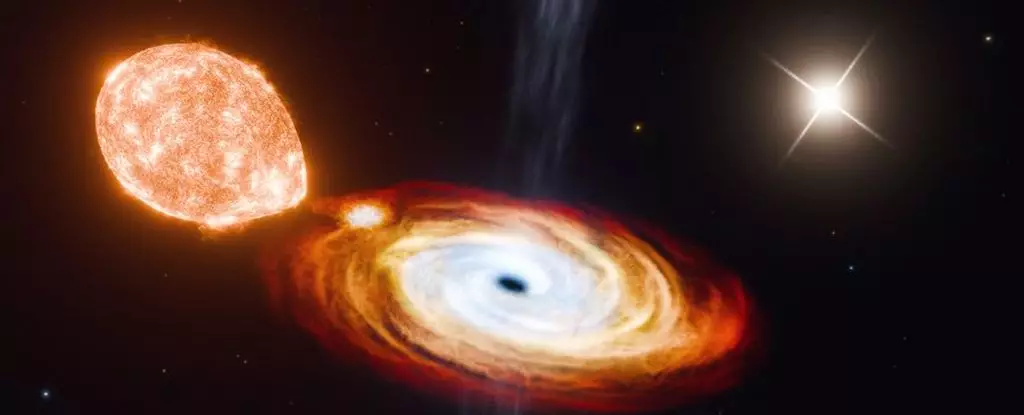In the vastness of the universe, black holes continue to captivate astronomers and astrophysicists with their enigmatic behaviors and extreme conditions. One such fascinating example lies in the constellation of Cygnus, where the system known as V404 Cygni is defying convention and expanding our understanding of black hole dynamics. Located approximately 7,800 light-years from Earth, V404 Cygni operates not as a mere binary system, but as a newly identified trinary ensemble. This discovery has significant implications for our theoretical frameworks regarding the genesis of black holes.
V404 Cygni is already known for its peculiar relationship with a close companion star that orbits it every 6.5 days, providing rich data for ongoing research. However, recent observations have revealed an additional companion, a star on a much wider orbit taking about 70,000 years to complete a revolution around the black hole. The presence of this third member not only complicates the mathematics of the system but also enriches the narrative surrounding the formation of black holes. The gravity-bound relationship among these celestial bodies strays from the expected behavior postulated by the supernova model of black hole formation, thereby opening the door to new hypotheses.
Traditionally, black holes have been thought to form predominantly through supernova explosions—cataclysmic events wherein massive stars eject their outer layers while collapsing under their own gravity. This model suggests that the violent nature of such explosions should disrupt the gravitational interactions of neighboring stars, especially those at significant distances. Yet, the discovery of the trinary configuration in V404 Cygni raises critical questions that challenge the existing paradigm.
Physicist Kevin Burdge from the Massachusetts Institute of Technology articulates this dilemma, highlighting that the newly uncovered relationship among the stars contradicts assumptions about the aftermath of a supernova event. V404 Cygni’s distinct arrangement poses an intriguing anomaly, suggesting that not all black holes trace their origins back to this explosive phenomenon.
The groundbreaking revelations about V404 Cygni were made possible by data collected from the European Space Agency’s Gaia mission, which meticulously maps the three-dimensional positions and velocities of objects within our galaxy. Such detailed observational tools enable astronomers to discern the gravitational connections between disparate stars. The findings indicate that both the close and distant companions of V404 Cygni are moving through space together, suggesting a deeper gravitational link. Hence, what was once a seemingly ordinary star system has transformed into a compelling case study for stellar evolution.
As researchers grapple with the implications of V404 Cygni’s trinary nature, another formation mechanism for black holes—direct collapse—comes to the forefront. This theory posits that a massive star can implode entirely into a black hole without the preceding chaos of a supernova. Such a scenario better accounts for the astonishing stability of the wider companion in V404 Cygni. Computer simulations conducted by Burdge and his colleagues reveal that this triple system configuration is most easily explained if the stars were already bound by gravity during the black hole’s formation.
The hypothesis that direct collapse might be common among black hole systems offers a profound shift in our understanding of black hole formation. By framing the conversation around the potential prominence of trinary systems in the cosmos, the scientific community is urged to reevaluate existing models and seek additional examples that might corroborate these findings.
Future Avenues for Exploration
The discovery of the V404 Cygni trinary system opens numerous avenues for future research. Questions remain regarding the potential existence of other trinary black hole systems that could elude current detection methodologies due to their stealthy nature. Uncovering additional examples would not only reinforce the viability of the direct collapse mechanism but could also illuminate previously hidden evolutionary pathways that black holes may undergo.
The story of V404 Cygni transcends the simple categorization of binary systems. Instead, it encapsulates the complexities of star formation and evolution, serving as a crucial reminder that the universe often operates beyond our current understanding. As we peel back the layers of cosmic mystery, the potential for groundbreaking insights and discoveries looms large on the horizon. Exploring the nuances of other celestial systems may continue to reshape our cosmic narratives for years to come, challenging assumptions and broadening our grasp of black hole formation and evolution.


Leave a Reply